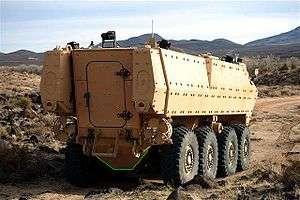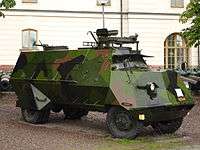V-hull

The V-hull is a type of vehicle armor design used on wheeled armored personnel carriers (APC), infantry mobility vehicles and infantry fighting vehicles (IFV). The design originated in the 1970s with vehicles such as the Leopard security vehicle[1] used in the Rhodesian Bush War[2] and South African armored vehicle company Land Systems OMC's Ratel IFV and Buffel.[3]
Design
The purpose of V-hulls is to increase vehicle and crew survivability by deflecting an upward directed blast from a landmine (or Improvised Explosive Device) away from the vehicle, while also presenting a sloped armor face.[4][5] By presenting its armor at an angle, it increases the amount of material a ballistic projectile must pass through in order to penetrate the vehicle, and increases the chance of deflection.
V-hulls are incorporated in armored vehicle designs in several different ways. Many vehicles, such as the BAE Systems RG-33 incorporate the V-hull into a monocoque chassis, while others, such as the ATF Dingo and International MaxxPro use a body-on-frame chassis, with an armored V-hull crew compartment, and an additional V or semicircular shaped piece protecting the driveline.[6] Others, such as the Cougar H have a V-hull crew compartment, and allow the driveline and suspension components to be sacrificed in an attack, while maintaining the safety of the crew.
Gallery
-

The Rhodesian Leopard security vehicle, one of the first V-hull vehicles.
-

A Casspir de-mining at the Bagram Airfield
-
Buffel variants at Air Force Base Swartkop
-

Force Protection's Cougar with a V-shaped hull hit by IED in Iraq, all crew survived
-
Intact hull after the drive train and utility bins were torn off after an IED to a Bushmaster IMV.
-

Terrängbil m/42 KP early V-hull vehicle and the first APC in the Swedish armed forces, in use between 1942 until early 1990. It saw combat during the Congo crisis.
See also
References
- ↑ "Leopard - Land Mine Resisting Vehicle". Retrieved 2008-07-18.
- ↑ "The Echos of an African War Archive". Retrieved 2008-07-18.
- ↑ http://www.machinedesign.com/ASP/strArticleID/59438/strSite/MDSite/viewSelectedArticle.asp
- ↑ Force Protection, Inc. - In the News
- ↑ Wood, David (2007-02-15). "Marines to trade in vulnerable Humvees". The Seattle Times.
- ↑ Defense Review - DefRev First Look: BAE Systems RG33 Series MRAP Vehicles